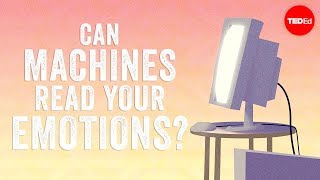(单词翻译:单击)
With every year, machines surpass humans in more and more activities we once thought only we were capable of.
每年,机器都逐渐在一些我们以前认为只有人类可以做的事情中超越人类。
Today's computers can beat us in complex board games,
如今,电脑可以在复杂的桌面游戏中打败我们,
transcribe speech in dozens of languages, and instantly identify almost any object.
能够转录各种语言,并能迅速识别几乎所有物体。
But the robots of tomorrow may go futher by learning to figure out what we're feeling.
而未来的机器人或许能在感知我们的情绪方面取得突破。
And why does that matter?
为什么这很重要?
Because if machines and the people who run them can accurately read our emotional states,
因为如果机器和操作他们的人可以准确地感知到我们的情绪,
they may be able to assist us or manipulate us at unprecedented scales.
他们可以前所未有地帮助我们,甚至是操纵我们。
But before we get there,
但是在这之前,
how can something so complex as emotion be converted into mere numbers, the only language machines understand?
我们先来探讨一下为什么像情绪这么复杂的东西可以被转化为数字,这种计算机唯一能够理解的语言呢?
Essentially the same way our own brains interpret emotions, by learning how to spot them.
本质上,机器理解感情的方式与我们大脑一样,通过情绪识别。
American psychologist Paul Ekman identified certain universal emotions
美国心理学家保罗·艾克曼定义了几种全球通用的情绪,
whose visual cues are understood the same way across cultures.
这些情绪的视觉信号在不同文化中是相同的。
For example, an image of a smile signals joy to modern urban dwellers and aboriginal tribesmen alike.
例如,微笑的画面对于现代城市人而言意味着愉悦,对于土著原始人而言也是如此。
And according to Ekman, anger, disgust, fear, joy, sadness, and surprise are equally recognizable.
根据艾克曼的理论,愤怒、厌恶、恐惧、愉悦、悲伤和惊喜都一样容易被识别。
As it turns out, computers are rapidly getting better at image recognition
事实证明,电脑的图像识别能力正在迅速提高,
thanks to machine learning algorithms, such as neural networks.
这归功于神经网络这样的机器学习算法。
These consist of artificial nodes that mimic our biological neurons by forming connections and exchanging information.
这些人工节点通过建成关联和交换信息,模仿人们的生物神经元。
To train the network, sample inputs pre-classified into different categories,
为了训练这样的网络,输入的样例被预分类到不同类别,
such as photos marked happy or sad, are fed into the system.
譬如被标记成快乐或伤心的图片,被输入到这个系统里。

The network then learns to classify those samples by adjusting the relative weights assigned to particular features.
然后,这个系统网络通过改变不同特征的比重来辨别不同的样例。
The more training data it's given, the better the algorithm becomes at correctly identifying new images.
这样的训练越多,算法就能更准确地识别新的图像。
This is similar to our own brains, which learn from previous experiences to shape how new stimuli are processed.
这一原理正与我们的大脑相像,我们的大脑依据过往的经历来处理新的刺激。
Recognition algorithms aren't just limited to facial expressions.
识别算法并不只限于面部表情。
Our emotions manifest in many ways.
我们的情感通过许多不同的方式被表露。
There's body language and vocal tone, changes in heart rate, complexion, and skin temperature,
比如肢体语言,语音语调,心跳的改变,面色和皮肤温度,
or even word frequency and sentence structure in our writing.
甚至写作的用词频率和句型结构。
You might think that training neural networks to recognize these would be a long and complicated task
你也许会认为通过训练神经网络来识别这些特征会是一个漫长而复杂的过程,
until you realize just how much data is out there, and how quickly modern computers can process it.
考虑到当下巨大的数据量以及现代电脑的数据处理速度。
From social media posts, uploaded photos and videos, and phone recordings,
从社交网络的更新,上传的图片和视频,电话录音,
to heat-sensitive security cameras and wearables that monitor physiological signs,
到热敏感安全摄像机和可穿戴的生理信号监视器,
the big question is not how to collect enough data, but what we're going to do with it.
关键问题并不是如何获得足够的数据,而是我们应该如何运用这些数据。
There are plenty of beneficial uses for computerized emotion recognition.
电子情感识别的用途是多方面的。
Robots using algorithms to identify facial expressions
比如,用算法识别面部表情的机器人
can help children learn or provide lonely people with a sense of companionship.
可以用于帮助儿童学习,或者为孤独的人作伴。
Social media companies are considering using algorithms
许多社交网络公司正在考虑使用算法
to help prevent suicides by flagging posts that contain specific words or phrases.
来标记帖子里的特殊字词以防范自杀行为。
And emotion recognition software can help treat mental disorders
情感识别软件可以帮助治疗精神疾病,
or even provide people with low-cost automated psychotherapy.
或者提供低价的自动化心理治疗。
Despite the potential benefits, the prospect of a massive network automatically scanning our photos,
尽管情感识别有这些好处,通过一个巨大的网络自动扫描我们的照片,
communications, and physiological signs is also quite disturbing.
通信和生理信号也让人感到不安。
What are the implications for our privacy when such impersonal systems are used by corporations to exploit our emotions through advertising?
当我们的隐私信息被这个没有人情味的系统收集,进而被公司利用到广告中来欺骗我们的感情,这意味着什么?
And what becomes of our rights if authorities think they can identify the people likely to commit crimes before they even make a conscious decision to act?
如果任何的权力机构认为他们可以在人们决定做任何事情之前就能辨别有可能作案的人,我们的权利又是什么?
Robots currently have a long way to go in distinguishing emotional nuances,
当前的机器人在辨别情感的微妙变化上还需要提升,
like irony, and scales of emotions, just how happy or sad someone is.
比如辨识讽刺以及识别情绪的程度,分辨一个人有多么的开心或者难过。
Nonetheless, they may eventually be able to accurately read our emotions and respond to them.
无论如何,它们或许终究能够正确识别我们的情绪并且做出回应。
Whether they can empathize with our fear of unwanted intrusion, however, that's another story.
至于他们能否体会到我们不想被过度入侵的恐惧,这就是另外一回事了。


